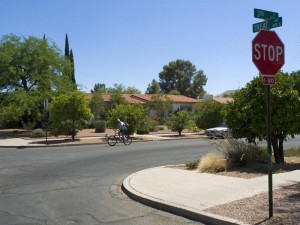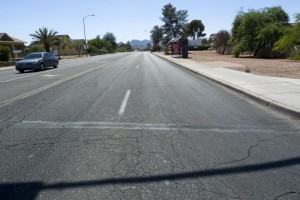In May, Tucson Velo readers voted on which road projects they would like to see completed.
Seven projects were listed, but the two most popular projects were the Treat Avenue bike boulevard (42 percent) and adding bikes lanes from Speedway and Euclid to Gates Pass (40 percent).
Here is what’s up with those two projects.
Treat Avenue bike boulevard

According to Tom Thivener, the city’s bike and pedestrian program manager, the Treat Avenue bike boulevard is a top priority but is lacking funding.
Thivener has submitted funding applications through the federal government’s transportation enhancement program and locally through the Regional Transportation Authority.
The boulevard will cost about $1 million for the five-mile section of Treat between the Aviation and Rillito bike paths.
Thivener said there are 15 schools, three parks and a library all within a half-mile of the corridor.
“It’s got it all but it needs a lot of work, especially with the major crossings,” Thivener said.
German Quiroga lives in the Barrio Centro neighborhood (located along Treat Avenue) agrees that the intersections are challenging.
“It would add a couple nice features,” Quiroga said. “Especially at Broadway, there is a need for a light there.”
Thivener said neighborhoods helped create the plan and organize support for the project.
Check out the concept and the application for federal transportation enhancement money.
Bike lanes on Speedway to Gates Pass

Both the City of Tucson and Pima County would be involved in adding bike lanes to Speedway.
There are several gaps in bike lanes within the city’s jurisdiction, which Thivener said poses some challenges. He said the section from Euclid to Stone is not wide enough to add a bike lane within the existing curbs, which means the city would have to push back the curbs and possibly purchase property.
“Right now it is cost prohibitive,” Thivener said.
Thivener said he is working on a way to get bikes under the freeway and connected to the bike lanes that are on west side of the interstate.
He said he isn’t sure how they will fix it, but it may involve using the sidewalk for a portion of the route.
The last bike-lane gap within the city’s jurisdiction is from Silverbell to Greasewood and while it doesn’t have curbs, it would require new pavement.
Chris Florko works for Pima Community College and is the reader who submitted the project for consideration in the vote. He said connecting the city’s portion would create a route that connects the University of Arizona and PCC’s Downtown and West campuses.
“If you are at downtown [campus] and you need to ride a bicycle out to the west, what do you do?” Florko said. “Once you get out on the other side of I-10 it is not bad, but you are taking your life into your hands when you try to get past I-10 from Pima Downtown to Pima West.”
Florko is also a road cyclist who often rides out to Gates Pass. He said adding a bike lane would make it safer for cyclists and vehicles in the area.
Florko said the tight turns scare motorists trying to squeeze by cyclists. “So I think for the safety of the cyclists and the motorists, I think it would be a big plus.”
Matt Zoll, Pima County’s bicycle and pedestrian program manager said it is realistic to add bike lanes on Speedway to Camino de Oeste, but beyond that it would be very difficult.
“It becomes a really, really challenging project really fast,” Zoll said. “Once you gets past Camino De Oeste the costs would probably run over $1.1 million a mile — easily much, much higher on the the steep part down to the horseshoe curve where the parking is.”
Florko said spending the amount of money would be worthwhile.
Is it worth a million dollars a mile to potentially save some peoples’ lives and or possibly funnel more tourists’ dollars out to the Desert Museum and Old Tucson?” Florko said “I think so.”
According to research Zoll has done, in the last 11 years there have been eight reported crashes between cyclists and motorists. He said the narrow road and slower speeds can actually be a natural traffic calmer, making it safer.
He suggested cyclists actually ride closer to the center of the lane and use their left arm to indicate drivers behind the cyclist should slow down. Once the traffic has slowed, the cyclist can move to the right and let the vehicles pass.
Florko recognizes that it may not be feasible, but is happy the city and county work hard on improving bicycle infrastructure.
“The City of Tucson and Pima County do a fantastic job with the many improvements they have made for cycling,” Florko said. “I think all of the cyclists who live in Tucson are lucky to have a government that is as responsive to the needs of cyclists, even if they can’t do everything we have on our wish list.”

13B in the Treat application mentions a RR bed … hope someone fixes this before they submit.
Good catch Jeff. I’ll get that fixed before the final application is due in August.
13B in the Treat application mentions a RR bed … hope someone fixes this before they submit.
I don't like to do things when I'm
on my bike that will result in bad
PR for cyclists. Sometimes they
just happen, but it's inadvertent.
Cars can see and understand why
bikes take the lane going down
Gates Pass road, especially the
West side. But taking the lane
going up is just being in the way.
I know how people feel about
speed bumps and I don't want
to be a living traffic calming
device. It's not a cyclist's job to
slow the traffic down. If you need
the lane to avoid a hazard, take it
and signal what you're doing if
there are cars behind. The Gates
Pass ride requires the skill to ride
closely to, if not on, the white line.
IMHO
I don't like to do things when I'm
on my bike that will result in bad
PR for cyclists. Sometimes they
just happen, but it's inadvertent.
Cars can see and understand why
bikes take the lane going down
Gates Pass road, especially the
West side. But taking the lane
going up is just being in the way.
I know how people feel about
speed bumps and I don't want
to be a living traffic calming
device. It's not a cyclist's job to
slow the traffic down. If you need
the lane to avoid a hazard, take it
and signal what you're doing if
there are cars behind. The Gates
Pass ride requires the skill to ride
closely to, if not on, the white line.
IMHO